ETHICS
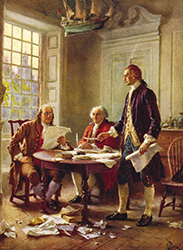
Credit: AKG 7EN-I1-014124 (IAM/akg)
Benjamin Franklin, John Adams, and Thomas Jefferson (left-to-right) writing the Declaration of Independence, 1776. Painting by Jean Léon Jérôme Ferris
Values, Ethics, and Mission Command: Trust as a Conscious Act of Force
by Dan McCauley
For more information on accessing this file, please visit our help page.
Dan McCauley is a National Defense University assistant professor at the Joint Forces Staff College located in Norfolk, Virginia. Professor McCauley is a retired USAF pilot and currently instructs national security strategy and theater campaign planning for senior US and international officers. He is pursuing his doctorate in Strategic Leadership.
“The earth always belongs to the living generation. They may manage it then, and what proceeds from it, as they please, during their usufruct…. Every constitution then, and every law, naturally expires at the end of 19 years. If it be enforced longer, it is an act of force, and not of a right.” ~Thomas Jefferson, 17891
Introduction
The U.S. Constitution never became the ‘living’ document that changed every generation as Thomas Jefferson envisioned. Instead, its principles and core values have remained steadfast throughout the centuries against many internal and external challenges, some mere fads, and others far graver. Circumstances change, however, and the conditions that existed when Jefferson, James Madison, and others established a fledgling nation uncertain of its continued existence have changed to one today in which the United States is positioned as the world’s sole superpower. As the nation matured, each change in environmental condition required a reexamination of its underlying principles and values. The abolishment of slavery, women’s suffrage, the establishment of social security, and gay rights are examples of such introspection and reevaluation.
Although the wars in Iraq and Afghanistan have changed the Joint Force in ways not yet fully known,2 there are visible signs that the values and ethics that have been the hallmark of U.S. operations suffer from neglect, or, at a minimum, are fraying around the edges. Examples of this neglect are evident throughout the Joint Force. Last summer, a military court convicted an Air Force instructor, one of 12 implicated in a sexual misconduct scandal, of raping one female recruit and sexually assaulting several others.3 Seven Army soldiers and two Marines received administrative punishment as part of the continuing Secret Service prostitution scandal from the spring of 2012. Additional fallout from that scandal resulted in one Air Force member reprimanded, while final decisions are pending on two Navy sailors.4
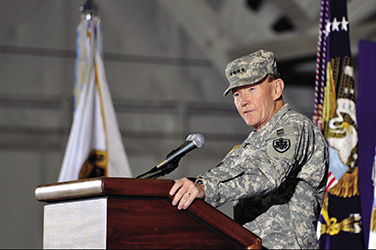
Credit: DefenseImagery.Mil photo 111220-FMG591-435 by Senior Airman Perry Aston
Chairman of the Joint Chiefs of Staff General Martin E. Dempsey.
Moral leadership not only consists of ethical beliefs and assumptions, but also actively and positively supports what is just or right. Moral decisions must be in consonance with ethical principles, unselfish,5 and positively reflect the Profession of Arms and those who are the guarantors of the Constitution.6 Every generation, including this one, must determine how it will live collectively and according to what agreed upon values. The Joint Force’s ability to define and inculcate its values or code of conduct across the Joint enterprise is critical to reducing the tension between competing operational and cultural requirements and in fully instituting the concept of mission command.
To achieve Chairman of the Joint Chiefs of Staff (CJCS) General Martin Dempsey’s vision of mission command, trust must be the cornerstone of the effort.7 Without trust, shared understanding and intent will be nothing more than empty platitudes that are acknowledged but ignored throughout the joint force. Without trust, a joint culture will espouse one set of values while acting upon another. This article posits that to achieve trust, one must begin with an understanding of values—its origins and development, and the effects of multiculturalism. Next, ethics or values-in-action are shown as the linkage between values and trust. Third, trust is explored as an intervening variable between a leader and organizational success. Fourth, leadership as expressed in mission command is analyzed. Finally, recommendations are proposed for developing trust throughout the Joint Force.
“To achieve Chairman of the Joint Chiefs of Staff (CJCS) General Martin Dempsey’s vision of mission command, trust must be the cornerstone of the effort.”
Values and Culture
In 1789, Thomas Jefferson wrote to his old friend, James Madison, that each generation was sovereign and that the rights and laws of one generation should not impede or limit future generations. Thus, each successive generation must determine through active measures the laws by which that generation will abide. Madison acknowledged Jefferson’s logic, but argued that there is value in stability, and “…without such continuity there is no nation.”8 As Madison clearly tells Jefferson, each generation is not self-contained or purely self-interested; rather each builds upon the other making improvements to be subsequently improved upon by later generations. Although Madison’s position was far more rational and logical, Jefferson’s point was that actions of past generations should not impede or limit their successor’s ability to act as they see fit.9 Each generation must understand the hard-earned sacrifices from previous generations as espoused in laws and values, and interpret them for application to the current context.
Whereas laws are legally binding,10 values are defined as “constructs representing generalized behaviours or states of affairs that are considered by the individual to be important.”11 Values provide the foundation for the Profession of Arms, which the Joint Force uses as a guide for personal and professional purposes. Values influence a person’s perception of situations and problems, and they influence preferences, aspirations, and choices.12 Often unspoken and taken for granted, values are frequently difficult to articulate. Part of the difficulty in defining values is that a range of behaviours may satisfy stated values, and contextual nuance often shapes value application. In all global organizations, personal or organizational values frequently conflict with other value systems, rather than supporting one another. In a multicultural strategic environment, the lack of a strong institutional commitment from Joint leadership regarding values and codes of conduct provides subordinates with little foundation for behaving ethically.13
Espoused values are “…the articulated, publicly announced principles and values that the group claims to be trying to achieve.”14 These values reflect a sense of what ought to be as opposed to what currently is. In essence, espoused values propose solutions about what the group or institution thinks is right or wrong, and what will or will not work. Within the group, leaders use their influence to persuade subordinates to adopt certain espoused values. Until the group takes action, however, and the members have observed the outcome of that action, a shared basis for understanding does not exist. If the espoused value works reliably and undergoes group or institutional validation, it then becomes a value.15 Individuals and groups learn that certain values work to reduce ambiguity in a group’s core functional area, such as in overseas operations. Organizational philosophies that embody codified values serve as a guide for addressing uncertainty and can predict most expected behavior within the environment.16
“Virtue-based theories are theories of character, and focus upon an individual’s disposition.”
Organizations operating on a global basis regularly face particularly tough ethical challenges because of various cultural factors. The greater the complexity of the environment, and the greater the operational domain within which the Joint Force is operating, the greater potential for ethical problems or misunderstandings to exist.17 Culture is an amalgamation of a complex whole consisting of beliefs, customs, knowledge, laws, morals, and other behaviour acquired by members of a society.18 A multicultural society must develop supra-ethnic values to achieve community consensus. Supra-ethnic values are agreed upon and accepted by all stakeholders, and are supportive of the more specific values of each sub-group.19 Unfortunately, supra-ethnic or universal values tend to be far weaker in comparison to community or group values, and frequently attract individuals, not because they are truthful, but because they are useful.20
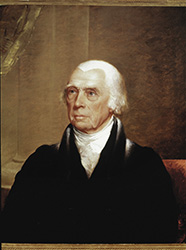
Credit: AKG 1US-14-A1809 (akg-images/Erich Lessing)
President James Madison. Painting by Chester Barding
Ethics
Ethical theory dates back to the early Greek philosophers, and the word “ethics” is derived from the Greek word “ethos,” meaning “character.” Ethics describe the kinds of values and morals an individual, organization, or community desires. With regard to leadership, ethics has to do with how leaders behave and their virtuousness.21 In his letter to Madison, Thomas Jefferson was alluding to a generation’s character and virtue. Jefferson believed that each generation was essentially the trustee of the nation’s values for future generations. When a trustee holds something in usufruct, there is an expectation that the worth of the item in question is not diminished in any way. In fact, it speaks volumes about the trustee’s character if improvements are not made.22 The examples of recent unethical or immoral behaviour exhibited by current members of the Joint Force speak to a lack of character or ethics. The lack of ethics undermines the trust that the American populace and the world expects, and impedes the ability of future generations of Joint Force warriors to execute operations successfully around the world.
The choices made by members of the Joint Force and how they behave in any specific situation “are informed and directed by their ethics.”23 Ethical theories fall within two broad domains: conduct and character. Theories that deal with conduct focus upon the consequences of one’s actions and the associated rules governing behaviour. The consequences of an individual’s actions determine the goodness or badness of a particular behaviour. Virtue-based theories are theories of character, and focus upon an individual’s disposition. These theories state that virtues are not innate, but learned and reinforced over time through familial and community enforcement.
Ethics is central to leadership. The values promoted by a leader establish and reinforce organizational values and have a significant effect upon the behaviour exhibited by personnel.24 Through the creation of a deep sense of moral values, and by conveying high levels of honesty and integrity when interacting with subordinates, leaders enhance subordinate social identification with the organization. Leaders must understand that their behaviour, good or bad, sends a strong message to the organization and directly affects how personnel think, decide, and act.25
Ethical codes are formal statements of an organization’s values regarding expected personal social responsibilities; they clarify to personnel what the organization stands for and its expectations for personal conduct. Although written codes are important, it is essential that leaders and commanders support and reinforce the codes through their actions, including rewards for compliance, and discipline for violations.26 Moral codes become problematic when individuals attempt to apply those values, originally espoused as good or bad, to specific situations. It is the application of values that makes the behavioural outcomes complicated, and that differs across cultures.27
Trust
Jefferson’s letter to Madison illustrates that he understood the often short-sightedness and present-mindedness of humankind, and he offered caution for decision makers. He rightfully asserted that those entrusted with the present generation must not violate the rights of future generations. A trustee is assumed to have the needs and interests of his or her clients in mind when acting on their behalf. A leader, much like a trustee, must also serve the needs and interests of his or her subordinates when acting on their behalf.
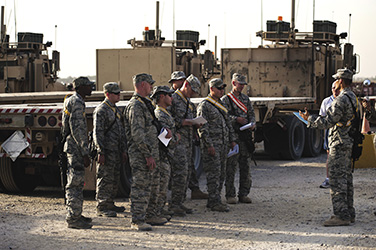
Credit: DVIDS photo 487134
US soldiers briefing for operation
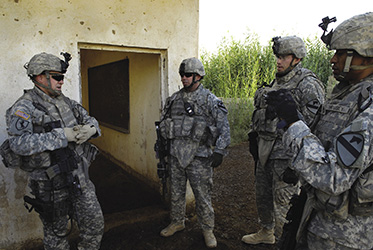
Credit : Defense Video & Imagery Distribution System (DVIDS) photo 59236
US soldiers briefing for operation
The key attributes of mission command are understanding, intent, and trust (Figure 1).28 Trust is defined as “a psychological state comprising the intention to accept vulnerability, based upon positive expectations of the intentions or behavior of another.”29 As applied to mission command, trust informs the execution of intent and must be resident at every level of the Joint Force. In other words, trust is the intervening variable that ties the independent variable, leadership, to the dependent variable, organizational success (Figure 2). A lack of trust severely limits intent and understanding and hinders the ability of the Joint Force to operate effectively.30 For trust to have its most far-reaching effects, it must not only reside within individuals, but also within an organization’s culture.
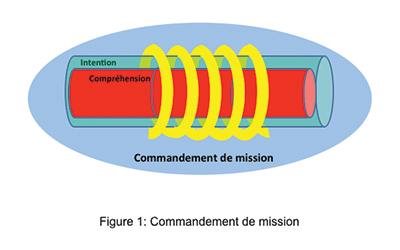
Credit: Dan McCauley
Figure 1: Mission Command
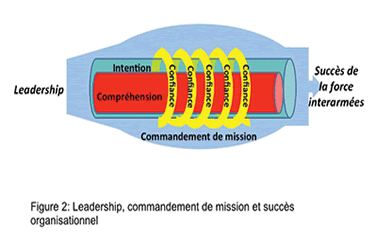
Credit: Dan McCauley
Figure 2: Leadership, Mission Command, and Organizational Success
Leadership, as the independent variable, creates a sense of trust that, in turn, leads to organizational success.31 Similarly, subordinate trust in leadership is a crucial element in the effectiveness of a leader.32 An organization that has developed trust between its leadership and subordinates reaps a number of direct and indirect benefits. For example, trust increases communication, cooperation, and information sharing; it increases satisfaction with and perceived effectiveness of leadership; it enhances organizational citizenship behaviours; it decreases personnel turnover; it improves team and organizational performance; and it increases organizational stability.33
Joint leaders who possess deep personal values and convictions and act accordingly build credibility and earn their subordinates’ respect and trust. Through the encouragement of diverse perspectives and the development of collaborative networks, leaders create an ethical environment that subordinates can recognize and emulate. Leaders directly influence their subordinates’ self-concepts through collaborative relationships, and aligning organizational and personal values and beliefs. By clearly conveying their values and vision to subordinates and engaging in discourse, leaders quickly develop the foundation upon which trust is built.34
Trust exists at every level within an organization: individual, team, leadership, organizational, and inter-organizational. Group or organizational experiences and interaction strengthen or weaken the manner in which trust is developed.35 Misalignment between senior leadership and members of an organization often occurs because of a failure of senior leaders to prioritize goals. As a result, this obligates mid-level leaders or commanders to address this failure, which often results in mixed signals and conflicting messages that undermine trust and confidence in all levels of leadership.36 Competing initiatives should be avoided if at all possible because the existence of many, rapidly shifting priorities destroys the credibility of the organization and undercuts the credibility of any change efforts.37
Leadership and Mission Command
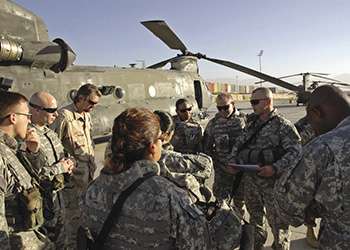
Credit: DVIDS photo 49876
US soldiers briefing for operation
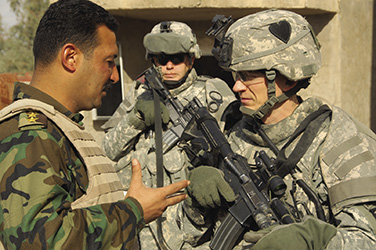
Credit: DVIDS photo 69553
US Army and Iraqi officers in consultation
The commander is the central figure in mission command38 and span of control directly affects his or her ability to communicate effectively with subordinates. Commanders of smaller organizations typically have more direct power and influence than in larger organizations because leadership is not diffused through layers of management. In smaller organizations, subordinates easily recognize commanders and constantly observe their behaviour. Therefore, commanders in smaller organizations possess a strong potential to establish high ethical standards for all decisions. Joint commanders whose organizations operate in unfamiliar or foreign landscapes may need to adjust ethical standards or expectations. If the commander fails to provide the proper environmental and ethical guidance, some personnel may engage in ‘rogue’ behaviour in an attempt to achieve their objectives. In other words, some personnel may fail to distinguish when crossing the line of good judgment and commit unethical acts when attempting to navigate their way through unfamiliar environments.39 With that mind, leaders throughout the organization must espouse, and, more important, model ethical behaviour.40
In mission command, values must not be abstract and theoretical—they must be acted upon. To achieve organizational goals, commanders must first communicate the desired outcomes to their subordinates and develop behavioral expectations to achieve those outcomes. Once identified and taught, subordinates must live by those expectations, and commanders must constructively confront those who violate them (Figure 3). Culture is ultimately defined by what commanders expect and what commanders tolerate.41 Trust in commanders is extremely important for the Joint Force as missions and tasks are highly complex, and they routinely call for high levels of interdependence and cooperation. Ultimately a reflection of values, trust is on display for all to see and judge.42
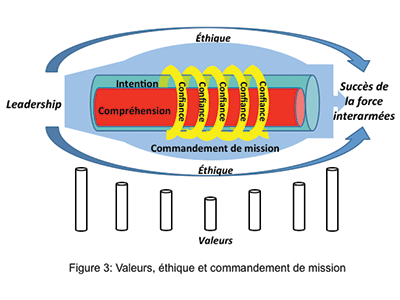
Credit: Dan McCauley
Figure 3: Values, Ethics, and Mission Command
Recommendations for the Joint Force
As Joint Force commanders become ethically attuned, they must learn to view the world through a variety of lenses, developing a personal sense of right and wrong. They must learn to interpret the influences that affect individual and group behaviour. In addition, commanders need also to develop sensitivity for U.S. public expectations. For current and future Joint Force commanders, this makes leadership extremely challenging as ethics become partly improvisational and intuitive.43 If commanders expect subordinates to alter their values and behaviour freely and to align them more closely with those of the organization, subordinates must trust their commander’s integrity and credibility.44 Commanders must understand that only a values-based organization—one that espouses and lives by its core values every day45—can provide the Joint Force with the requisite creativity and critical thinking skills necessary to operate in a dynamic strategic environment.46 Commanders can take the following steps to develop and institutionalize trust throughout their organizations:
Develop organizational values. Values serve as a guide for dealing with the uncertainty of inherently difficult events or unfamiliar situations. They provide individuals with a sense of what is right and wrong and enable organizations to respond more effectively in times of adversity.
Promote ethical behaviour. Values strengthen an individual’s sense of right and wrong and provide guidelines for expected behaviour. Subordinates with a strong understanding of organizational values know the right thing to do when encountering difficult or unfamiliar circumstances.
Reinforce a values-based organizational culture.Values provide the foundation for an organization’s culture. Given today’s multicultural organizations and operating environments, the development and modeling of supra-ethnic values that complement specific subgroup cultures will reinforce the desired expectations.
Foster a sense of community. Shared core values create a sense of community in organizations. As subordinates start to understand they are working toward a common goal and share the same values as the organization, they develop a sense of cooperation and commitment.
Promote a learning environment. Subordinates who have a sense of ownership within an organization are more likely to take risks or seize opportunities to improve their skills and practices. A sense of community helps individuals feel more connected to their work and, as a result, become more creative and open to new ideas and practices.
Support leadership development. Values training teaches future leaders that by linking their personal values to organizational values and living them, leaders set a positive example for those around them and influence the behaviours of others.
Commanders must develop a sense of morality and a desire to act in the long-term interests of others. Moral commanders demonstrate high degrees of ethical conduct time and again and view themselves as the organization’s ‘standard bearer.’’ A commander’s ethical behaviour carries a powerful message to subordinates that directly influence what they think, and ultimately, how they act. Over time, the ethical behaviour of a leader affects everyone within the organization and becomes a part of its culture.47
Conclusion
Most Joint organizations today are constrained by so many rules and regulations that even commanders at the highest levels do not have to ‘lead’ anyone anywhere. Many of today’s leaders simply follow policy, obey regulations, and operate at the head of the organization. Such leaders lead only in “…the sense that the carved wooden figurehead leads the ship.”48 Mission command is not an unthinking process—it challenges commanders to “…develop mutual trust and understanding and exercise moral nerve and restraint.”49 Thus, mission command requires commanders to take a far more active role in developing shared understanding and trust within their organizations.
Every day, unanticipated events demand near-instantaneous decisions that have no straightforward answers. These decisions can have long-term implications for personnel, organizations, and nations. Often times, the costs associated with a decision are unknown until well after the fact. The uncertainty associated with decision-making creates a tension between what one can readily adapt to and what one must unequivocally oppose, especially when confronting the powerful and resisting external pressure.50 It is this very uncertainty that demands institutional values and a code of conduct to guide51 the Joint Force as it executes operations around the world.
As Thomas Jefferson wrote over 220 years ago, if laws and values are to be extended from one generation to the next, it takes a conscious act of force. As the United States, and the Joint Force in particular, transitions from two major conflicts while continuing to execute operations around the world, there is an opportunity and responsibility to reflect upon the lessons learned. Although Jefferson’s main argument raised as many questions as it answered, he provided a concept for current Joint leaders to begin the integration of the lessons learned into a code of conduct for future generations of soldiers, sailors, airmen, and marines. The Joint Force, specifically its senior leadership, must determine how war has changed the force; it must determine the Joint Force’s collective values;52 and it must “decide and act on the best course of action to follow,”53 to implement the concept of mission command.
Notes
- Joyce Appleby and Terence Ball (eds.), Thomas Jefferson: Political Writings. (Cambridge, MA:: Cambridge University Press, 1999), pp. 593-598.
- M. Dempsey, (2012a). Chairman’s strategic direction for the joint force. Washington, DC: US Government Printing Office.
- W. Wessert (2012). “Air Force instructor convicted of raping recruit,” in Associated Press, at <http://news.yahoo.com/air-force-instructor-convicted-raping-recruit-022859553.html>.
- The Associated Press (AP). (2012). “No charges for military in prostitution scandal,” in Air Force Times, 18 July 2012, at :< http://www.airforcetimes.com/news/2012/07/ap-no-charges-prostitution-secret-service-scandal-military-071812/>.
- A. Carroll (2000). “Ethical challenges for business in the new millennium: Corporate social responsibility and models of management morality,” in Business Ethics Quarterly, Vol. 10, Issue 1.
- Dempsey (2012a).
- M. Dempsey (2012b). Mission Command, White Paper. (Washington, DC: US Government Printing Office, 2012).
- T. Ball (2000). “‘The earth belongs to the living’: Thomas Jefferson and the problem of intergenerational relations,” in Environmental Politics, Vol. 9, Issue 2, pp. 61-77.
- Ball (2000).
- Merriam-Webster’s Collegiate Dictionary, Tenth Edition. (Springfield, MA: Merriam-Webster, Inc., 2001), p. 658.
- G. Yukl, (1989). Leadership in organizations. (Englewood Cliffs, NJ: Prentice Hall, 1989), p. 188.
- Ibid.
- T. Donaldson (1996). “Values in tension: Ethics away from home,” in Harvard Business Review, September-October 1996.
- E. Schein (1992). Organizational culture and leadership, (San Francisco, CA: Jossey-Bass, 1992), p.20.
- Ibid.
- Ibid, p. 21.
- R. Daft, (2010). Theory and design of organizations, (Singapore: Cengage Learning, 2010).
- W. Wines & N. Napier (1992). “Toward an understanding of cross-cultural ethics: A tentative model,” in Journal of Business Ethics, Vol. 11.
- J. Smoliez (1981). “Core values and cultural identity,” in Ethnic and Racial Studies, Vol. 4, No. 1.
- R. Boudon (2001). The origin of values. (New Brunswick, NJ: Transaction Publishers, 2001).
- Northouse, P. Northouse (2007). Leadership, (Thousand Oaks, CA: Sage Publications, 2007).
- Ball (2000), p. 67.
- Northouse (2007), p. 342.
- Ibid.
- B. Avolio, W. Gardner, F. Walumbwa, F. Luthans, & D. May, (2004). “Unlocking the mask: A look at the process by which authentic leaders impact follower attitudes and behaviors.” in The Leadership Quarterly, Vol. 15.
- Daft (2010).
- Wines & N. Napier, N. (1992). “Toward an understanding of cross-cultural ethics: A tentative model.” in Journal of Business Ethics, Vol. 11.
- M. Dempsey (2012b). Mission Command, White Paper. (Washington, DC: US Government Printing Office, 2012).
- Avolio et al. (2004), p. 810.
- Dempsey (2012b).
- S. Reinke (2004).” Service before self: Towards a theory of servant-leadership,” in Global Virtue Ethics Review, Vol. 5, No. 3.
- Avolio et al. (2004).
- C. Burke, D. Sims, E. Lazzara, & E. Salas, (2007). “Trust in leadership: A multi-level review and integration,” in The Leadership Quarterly, Vol. 18.
- Avolio et al. (2004).
- Burke, et al. (2007).
- C. Prahald & G. Hamel, (1994). “Strategy as a field of study: Why search for a new paradigm?” in Strategic Management Journal, Vol. 15, Issue S2, pp. 5-16.
- T. Simons (1999). “Behavioral integrity as a critical ingredient for transformational leadership,” in Journal of Organizational Change Management, Vol. 12, Issue 2.
- Dempsey (2012b).
- D. Kuratko (2007). “Entrepreneurial leadership in the 21st Century,” in Journal of Leadership and Organizational Studies, Vol. 13, No. 4.
- Daft (2010).
- L. Runy (2008). “Leader and values in uncertain times.” in Hospital and Health Networks, Vol. 83, Issue 10.
- Hasan, A. Hasan & F. Ahmed, Authentic leadership, trust and work engagement. World Academy of Science, Engineering and Technology, Vol. 80.
- B. McCoy, (2007). “Stand up for your values,” in Leader to Leader, Summer 2007.
- Simons (1999).
- Runy (2008).
- Dempsey (2012b).
- D.May, T. Hodges, A. Chan, & B. Avolio, (2003). “Developing the moral component of authentic leadership,” in Organizational Dynamics, Vol. 32, No. 3.
- J. Gill, (2005). “Educating for leadership,” in Human Development, Vol. 26, No. 2, Summer, p. 21.
- Dempsey (2012b), p. 5.
- McCoy (2007).
- Runy (2008).
- Dempsey (2012a).
- S. Morse, (1989). “Developing the citizen leader,” Vital Speeches of the Day, Vol 56, Issue 3, p. 81.







